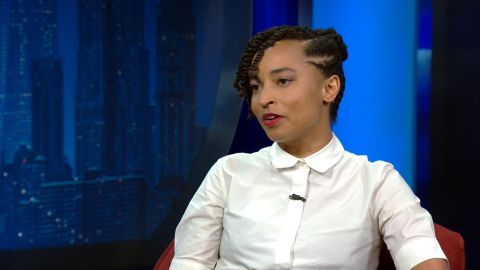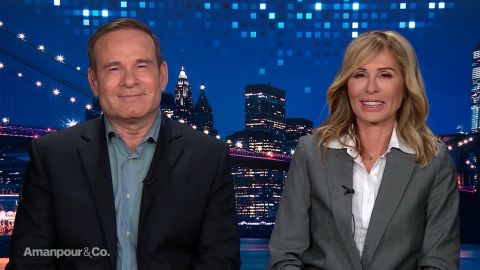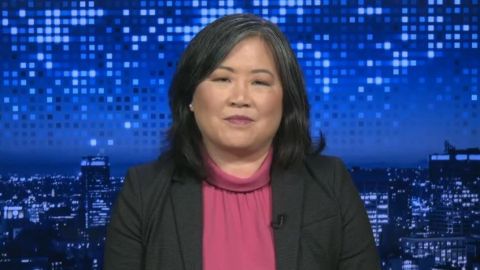Read Transcript EXPAND
CHRISTIANE AMANPOUR: Now, our next guest is the co-curator of the most important contemporary art collection in America, the 2019 Whitney Art Museum Biennial in New York City. It is an unmissable event in the creatives’ calendar, and Rujeko Hockley gave our Alicia Menendez, a sneak peek.
ALICIA MENENDEZ, PBS HOST: You’re a curator at the Whitney Museum. You’re tapped to co-curate the prestigious 2019 Whitney Biennial with Jane Panetta. For someone who doesn’t know who is not in the art world, what is the Biennial? Why is it so important?
RUJEKO HOCKLEY, CO-CURATOR, WHITNEY ART MUSEUM BIENNIAL 2019: The Biennial is the longest running survey of American Art in the world, and it has been running since 1932. And it is cited at the Whitney Museum. So it’s unique in that it has this very long history, and also that it is associated specifically with one museum. And, you know, wherever the Whitney is, whether we are uptown, or whether we’re downtown now, that is where the Biennial happens. Additionally, it happens every two years, and it has kind of developed a reputation of being where you go to look to see what’s happening in American art. And so where you kind of maybe go to discover new names, new people, kind of new ideas. So this idea that it’s a snapshot every two years of what’s happening in contemporary art, I think is what gives it its charge and what gives it its reputation.
MENENDEZ: So what will be the snapshot this year? What is the state of American art?
HOCKLEY: Well, the state of American Art, I think, is really multifarious. There is no — what we found — Jane and I, in our research is that there isn’t any one particular thing that artists are doing. And this is probably always been true, but I think we found it even to an even greater extent. What I will say though, is that in the historical moment that we’re living through, we found artists incredibly interested in looking at the past not as a way of kind of hiding in the past, but actually is a way of thinking productively and generatively and forward thinking about what we can take from the past, used in our current moment, used to reframe our current moment and then project forward into the future. And along those lines, questions relating to racial justice to questions of gender, questions of class, questions of access, these are things that artists are really thinking about, and we found kind of all over the country, people were interested in thinking about these question and their work.
MENENDEZ: You said in your research for the Biennial, what does that research look like?
HOCKLEY: It involves a lot of traveling, a lot of notes and lists on my phone. Jane, and I spent about 14 weeks on the road, cumulatively, fortunately, not consecutively. And we did over 300 studio visits in approximately 25 different locations. So it involves a huge amount of travel, and a huge amount of kind of synthesizing information and generating lists, going on studio visits kind of checking back in and kind of — it’s a really an iterative process.
MENENDEZ: You were in Puerto Rico and Houston. Did you see — has there been a resurgence of art that was tied to Hurricane Maria? Like, is there a post Hurricane Maria art scene?
HOCKLEY: There is one artist in the Biennial — there are several artists in the Biennial, I should say who are from Puerto Rico. But one artist in particular, Daniel Lind-Ramos, he has a piece called “Maria, Maria.” And it is a kind of direct reference to the hurricane. But it’s at the same time a dual reference to the hurricane as well as the Virgin Mary. And so kind of toggling between those two things and those two references. But yes, absolutely.
MENENDEZ: The Biennial would not be the Biennial without its critics.
HOCKLEY: Obviously not.
MENENDEZ: Among them, this year, those who argue that you’ve played it safe.
HOCKLEY: Yes.
MENENDEZ: What do you say to that?
HOCKLEY: You know, I think that there’s a certain expectation around radicality and I say, radicality kind of in the air quotes, because, for me, and I think for many of the artists in the exhibition, the idea that, you know, everything, fell off a cliff and went to hell because Trump got elected is really laughable. You know, I think if you’re a student of American history, tell me a time when things have not been crazy and specifically tell me a time when things have not been crazy for people of color, for women, for people who are quote, unquote, “minorities” and outside of the mainstream for whatever reason. And so I think, for me that the idea that we would somehow kind of have this incendiary Biennial that would respond to this new context feels disingenuous, because that’s not — this is kind of have a piece with yes, some things are heightened and are incredibly intense and different. But it is also of a piece with our history and kind of I think that’s something that has fallen out, sometimes in the way we think about our moment and the way we certainly think about an exhibition like the Biennial.
MENENDEZ: You also have one artist who dropped out in protest because the Museum Vice Chairman, who is the Chief Executive of a company at the manufactures equipment, which includes body armor, which they sell to military and law enforcement agencies. What happens when the institution becomes part of the controversy?
HOCKLEY: Well, I mean, we’re — it’s happening. We’re seeing it play out right now, and I think these are also larger questions. You know, it’s not — the Whitney is kind of certainly right now under kind of specific scrutiny around this issue, but these are issues relating to institutions in general. I think that we have been really lucky in that the Biennial has — one artist did drop out, Michael Rakowitz. And, of course, that was his decision.
HOCKLEY: But otherwise, the Biennial has really maintained and we’ve — Jane and I have really been able to keep the Biennial together and keep the artists kind of focused and keep ourselves focused on the task at hand, which is really our exhibition that we’ve been working on for almost two years. But it raises a lot of interesting questions.
MENENDEZ: Who is the Biennial for?
HOCKLEY: The Biennial is for the artist on some fundamental level, and I think that Jane and I felt that and feel that very strongly that the Biennial, you know, is about them. But outside of that, the Biennial is for the public. The Biennial is for the thousands and thousands of people that come to the Whitney every week. And in this case, we’re open over the summer, which is really exciting. It’s kind of our highest visitorship moments in the year. And I think it’s interesting, because we now have a huge numbers of tourists coming to the Whitney compared to when we were uptown. And so I think very much about like, what are we telling people who maybe aren’t from here about the United States? About American art?
MENENDEZ: Three quarters of the participants this year, under the age of 40, only five have ever exhibited at a Whitney Biennial before. Was this deliberate to showcase hot new young talent?
HOCKLEY: It was deliberate in some ways, but not so much for that reason. It was deliberate, because I think as we did our traveling around the country, what we heard kind of over and over and over again was the kind of relentless pressure that is placed on artists, specifically in this economic climate. And so whether people were talking about having to move studios multiple times because affordable studio space is really not a thing, frankly, or they are having to move apartments because affordable housing is also not exactly a thing, or they were talking about debt accrued to do MFA programs, because for the same reason. We were just over and over hearing that there’s — this was a really difficult time in many ways to be a young artist. And that, of course, the same economic pressures were having knock on effects on smaller and mid- sized galleries, which historically would have supported an artist at a younger, earlier stage in their career. And so I think we just felt, given that the Biennial is this big platform, given that it has kind of such weight in the world that it felt really meaningful and critical, actually, to open it up to as many voices as we could and to really think about new voices, specifically.
MENENDEZ: Talk to me a little bit more about that, though. I mean, I think there, there’s always been this mystique of the starving artist and this idea that I mean, of course, there’s going to be an economic challenge. You’ve chosen to become an artist as opposed to it actually interfacing with larger structural questions of affordability.
HOCKLEY: Well, I mean, I think you just hit the nail on the head, because I think it actually does interface with larger structural questions, because the mystique of being a starving artist is, you know, it’s just that, it’s fantasy. Nobody says, “Oh, you know what I want to live in precarity for the rest of my life. I want to get to be 65 years old and have no pension, because there’s no safety net built into the society that I live in.” And I often say like we think of — people often ask artists to do things for free. But you would never ask your doctor to see you for free, you know, you would never ask your teacher to teach your children for free. Also, a poorly compensated field. And so I think there’s this idea that artists — that it’s not a job, that it’s like some sort of — that it doesn’t have the same weight and that the people who do that don’t have the same needs, don’t have bills, don’t have you know, groceries to buy, don’t have ailing parents et cetera. So that we think of artists, sometimes in this fantasy category of people who don’t have all the same issues and problems and pressures that the rest of us have, when in fact, they have all of those, and if we think about our culture more broadly, artists really drive the conversation, not just in the art world, but we think about movies, we think about novels, we think about, certainly museums and art, but we think about advertising. We think about kind of — all of these things, creative people, often artists are the people who are driving them and we don’t think about them as people who necessarily need to be supported.
MENENDEZ: Tell me that some of the artists you are most excited about?
HOCKLEY: Well, there’s 75 artists in the Biennial, so I love them all equally.
MENENDEZ: No favorite children.
HOCKLEY: For the record, no favorite children. But I think that there’s a couple of really incredible moments in the Biennial and some incredible artists that really push themselves in specific ways. I think everybody did. But for example, Nicole Eisenman, who is actually one of the artists who has been in the Biennial before and this is her third Biennial. But she had this idea for a really amazing and elaborate sculptural installation on one of our terraces. And she really was committed to doing it and really wanted to do it. And so the invitation kind of became about that specific project.
HOCKLEY: The piece is called “Procession” and it’s on our sixth floor terrace, and it’s a series of figurative sculptures, although kind of not exactly one to one with people, but recognizable as people moving across the terrorists kind of from right to left. And also, Nicole’s work is really known for having a lot of humor and so this piece is no different. There’s a lot of kind of tongue in cheek references. Kind of not winking in terms of exclusionary, but just like not take ourselves too seriously. But at the same time, there’s a real charge to the work, there’s a real kind of politic to the work. Another artist is Alexandra Bell. And Alexandra Bell is an artist based here in New York who has a series of screen prints in the Biennial, 20 screen prints that look at the Central Park 5. And of course, this is kind of in the news right now, with when they see us, it’s also — it’s the 30th Anniversary of their case. Alex has made a piece that looks actually at how the case was represented in the media. So rather than looking at exactly what happened, she has really isolated various pages from specifically “The New York Daily News,” and the kind of tracked over time from the April 1989 onwards, the ways in which these young boys were talked about in the media.
And she uses different strategies such as kind of highlighting and kind of actually blocking out — text blocking out images, she used to train journalists. So she came to art kind of sideways thinking about actually media as a person who was trained to produce media. So I think it’s a work that’s incredibly timely, for obvious reasons. But it’s also a work that makes bigger — causes us to think in a more broad way and in a bigger way about the world that we live in and the information that we’re receiving. And if there’s anything in the exhibition that I feel like does really connect squarely to this moment, and to kind of a potential radicality or kind of referendum on where we are right now, I think it is this idea of like looking and kind of thinking and not kind of making quick pronouncements. The kind of hot takes, the kind of like people responding to things without even really thinking through what they’re saying. I think we see that so much. And we’re certainly seeing that in our media escape right now.
MENENDEZ: How about Brendan Fernandes as the master in form.
HOCKLEY: That is another kind of really special piece —
MENENDEZ: I have questions about it.
HOCKLEY: Oh, please ask away. Brendan is an artist based in Chicago and he is somebody who was trained as a ballet dancer in his early life and then moved into being a fine artist. And this is kind of one of the first times that we’ve really seen him bringing those two sides of his practice together, those two sides of his training. So the installation exists on the fifth floor of the Whitney as a sculptural installation, a really beautiful kind of poetic installation, but it also exists as a site for performance. So something that was really important to us in doing the Biennial was thinking about the space and role of performance and thinking about how to bring performance into something like a Biennial, which isn’t always a perfect fit. It can be difficult for various reasons. And so Brendan’s installation is one of the few that really is doing both. It exists as an object, as a sculpture. It also exists as a performance three times a week.
MENENDEZ: How long are those ballerinas holding their positions for? That’s my question.
HOCKLEY: I mean, they do three one-hour performances. They get breaks in between. But I mean, they’re all professional dancers. They are all trained dancers. And so I think that’s part of what Brendan was really interested in the piece is kind of unpacking some of that rigor and that discipline of ballet, but also the kind of way in which the discipline and rigor can even veer into a sort of masochism.
MENENDEZ: You grew up in the D.C. area. You have access to the Smithsonian. How does having that type of access to museums shape your understanding of art?
HOCKLEY: Deeply and completely. I think that it is not an accident that I spent kind of my very early childhood years in a city that had completely free museums, not just museums, zoo, planetarium, art museums, science museums, natural history museums, that all of these spaces were available to us specifically, us meaning myself and my parents, an immigrant family who came to United States, for my mother to go to graduate school in Washington and would not necessarily have had the means to do that, would not actually have been able to bring their child to all these museums literally on a weekly basis. And so it for me, it was incredibly formative and I still — you know, I think about it a lot and what it means, how we kind of open as I said previously, how do we open up our institutions to as many people as possible? Because it can be transformative.
MENENDEZ: Thank you so much.
HOCKLEY: Thank you.
About This Episode EXPAND
Christiane Amanpour speaks with Kris Kobach and Cecillia Wang about Trump’s racist tweets. Steven M. Gillon and Carole Radziwill join the program to discuss the 20th anniversary of John F. Kennedy Jr’s death. Rujeko Hockley sits down with Alicia Menendez to discuss the Whitney Biennial 2019.
LEARN MORE



